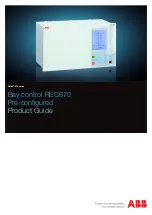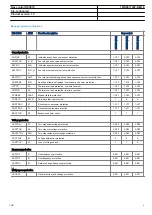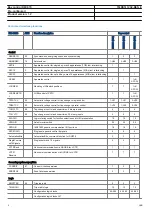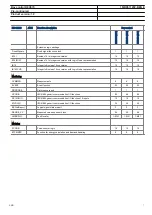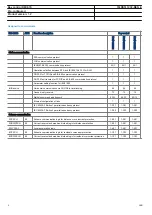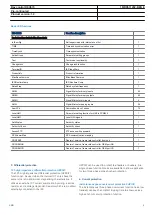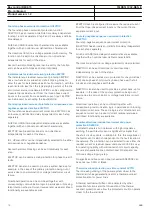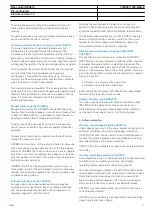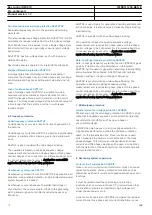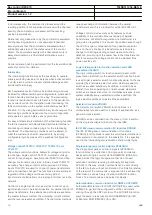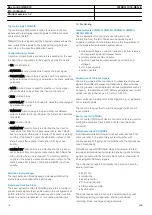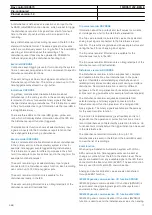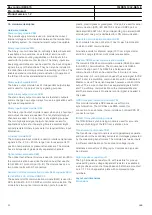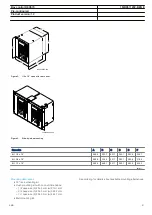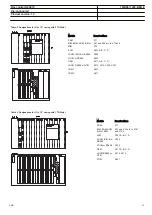
with the neutral point current on a separate input taken from
another set of cores on the current transformer.
A detection of a difference indicates a fault in the circuit and
is used as alarm or to block protection functions expected to
give unwanted tripping.
Fuse failure supervision SDDRFUF
The aim of the fuse failure supervision function (SDDRFUF) is
to block voltage measuring functions at failures in the
secondary circuits between the voltage transformer and the
IED in order to avoid unwanted operations that otherwise
might occur.
The fuse failure supervision function basically has three
different algorithms, negative sequence and zero sequence
based algorithms and an additional delta voltage and delta
current algorithm.
The negative sequence detection algorithm is recommended
for IEDs used in isolated or high-impedance earthed
networks. It is based on the negative-sequence measuring
quantities, a high value of voltage 3U
2
without the presence
of the negative-sequence current 3I
2
.
The zero sequence detection algorithm is recommended for
IEDs used in directly or low impedance earthed networks. It is
based on the zero sequence measuring quantities, a high
value of voltage 3U
0
without the presence of the residual
current 3I
0
.
For better adaptation to system requirements, an operation
mode setting has been introduced which makes it possible to
select the operating conditions for negative sequence and
zero sequence based function. The selection of different
operation modes makes it possible to choose different
interaction possibilities between the negative sequence and
zero sequence based algorithm.
A criterion based on delta current and delta voltage
measurements can be added to the fuse failure supervision
function in order to detect a three phase fuse failure, which in
practice is more associated with voltage transformer
switching during station operations.
9. Control
Synchrocheck, energizing check, and synchronizing SESRSYN
The Synchronizing function allows closing of asynchronous
networks at the correct moment including the breaker closing
time, which improves the network stability.
Synchrocheck, energizing check, and synchronizing
(SESRSYN) function checks that the voltages on both sides of
the circuit breaker are in synchronism, or with at least one
side dead to ensure that closing can be done safely.
SESRSYN function includes a built-in voltage selection
scheme for double bus and 1½ breaker or ring busbar
arrangements.
Manual closing as well as automatic reclosing can be
checked by the function and can have different settings.
For systems which are running asynchronous a synchronizing
function is provided. The main purpose of the synchronizing
function is to provide controlled closing of circuit breakers
when two asynchronous systems are going to be connected.
It is used for slip frequencies that are larger than those for
synchrocheck and lower than a set maximum level for the
synchronizing function.
Autorecloser SMBRREC
The autorecloser SMBRREC function provides high-speed
and/or delayed auto-reclosing for single or multi-breaker
applications.
Up to five three-phase reclosing attempts can be included by
parameter setting. The first attempt can be single-, two and/
or three phase for single phase or multi-phase faults
respectively.
Multiple autoreclosing functions are provided for multi-breaker
arrangements. A priority circuit allows one circuit breaker to
close first and the second will only close if the fault proved to
be transient.
Each autoreclosing function is configured to co-operate with
the synchrocheck function.
Apparatus control APC
The apparatus control functions are used for control and
supervision of circuit breakers, disconnectors and earthing
switches within a bay. Permission to operate is given after
evaluation of conditions from other functions such as
interlocking, synchrocheck, operator place selection and
external or internal blockings.
Apparatus control features:
• Select-Execute principle to give high reliability
• Selection function to prevent simultaneous operation
• Selection and supervision of operator place
• Command supervision
• Block/deblock of operation
• Block/deblock of updating of position indications
• Substitution of position indications
• Overriding of interlocking functions
• Overriding of synchrocheck
• Operation counter
• Suppression of Mid position
Two types of command models can be used:
• Direct with normal security
• SBO (Select-Before-Operate) with enhanced security
Bay control REC670
1MRK511232-BEN E
Pre-configured
Product version: 1.2
ABB
13
Содержание Relion 670 series REC670
Страница 1: ...Relion 670 series Bay control REC670 Pre configured Product Guide ...
Страница 83: ...83 ...

